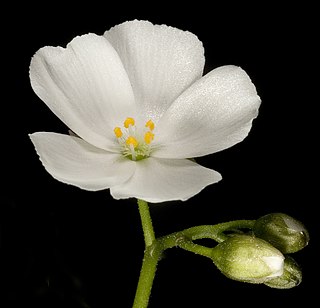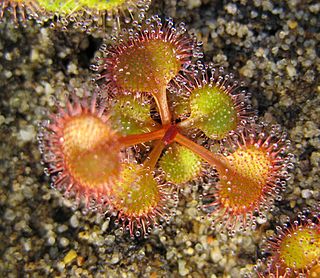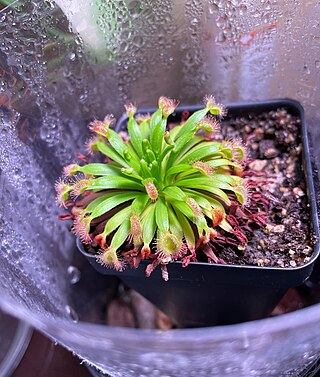The genus Drosera was divided in 1994 by Seine & Barthlott into three subgenera and 11 sections on the basis of morphological characteristics.
Drosera fimbriata, the Manypeaks sundew, is a perennial tuberous species in the genus Drosera that is endemic to Western Australia. It grows to 10 to 15 cm tall with two or three whorls of non-carnivorous leaves on the lower portion of the stem and 2 to 5 whorls of carnivorous leaves above that. It is native to a region mostly around Manypeaks but with populations near the Scott River and near Denmark. It grows in winter-wet sandy soils in heathland. It flowers in October.
Drosera humilis is a perennial tuberous species in the genus Drosera that is endemic to Western Australia. It has 3 to 5 semi-erect stems that are 3 to 15 cm long with carnivorous leaves arranged in whorls around the stems. It is native to a region from the Moore River north to Kalbarri and east to Ajana and Wongan Hills. It grows in winter-wet sandy soils in heathland. It flowers from June to September.

Drosera monticola is a perennial carnivorous plant species in the genus Drosera, the sundews. This species is endemic to a single mountain range in Western Australia.

Drosera platypoda, the fan-leaved sundew, is a tuberous perennial species in the genus Drosera that is endemic to south-west Western Australia. It grows 15 to 20 cm tall with a basal rosette of leaves with alternate cauline leaves along the stem. It is native to a region from Manjimup south-west to an area around the Scott River and east to Cape Riche. It grows in winter-wet sandy soils in heathland. It flowers in October.

Drosera porrecta is a tuberous perennial species in the genus Drosera that is endemic to Western Australia. It grows up to 45 cm tall. It is native to a region from Eneabba and Marchagee south to an area around Pinjarra, including the Darling Range and Mount Cooke. It grows in well-drained sandy soils and flowers from July to September.
Drosera prostrata is a tuberous perennial species in the genus Drosera that is endemic to Western Australia. It produces 4 to 5 prostrate lateral stems that are 3.5 to 15 cm long. The prostrate growth habit is what sets it apart from all other members of the section Stolonifera. It is native to a region along the Western Australian coast from the Tamala area near Shark Bay south to Binnu. It grows in well-drained sandy soils and flowers from May to June.
Drosera purpurascens is a compact tuberous perennial species in the genus Drosera that is endemic to south-west Western Australia. It produces 1 erect or 2 to 5 semi-erect lateral stems that grow to 3 to 10 cm long. The compact size of the plant combined with relatively long petioles distinguish it from all other members of the section Stolonifera. It is native to a region from Mount Cooke to near Katanning and Ongerup south to the Denmark-Albany region. It grows in sand-laterite soils and flowers from July to October, flowering en masse after bushfires.

Drosera ramellosa, sometimes referred to as the branched sundew, is a tuberous perennial species in the genus Drosera that is endemic to Western Australia. It was first formally described by Johann Georg Christian Lehmann in 1844. It was again described by Jules Émile Planchon as Drosera penduliflora in 1848, which was reduced to synonymy under D. ramellosa in 1864 by George Bentham.

Drosera rupicola is a tuberous perennial species in the genus Drosera that is endemic to Western Australia. It produces 3 to 5 semi-erect lateral stems that grow up to 15 cm long. The turbinate tuber and mobile lamina that are capable of folding over prey distinguish it from all other members of the section Stolonifera. It is native to a large inland region from Pithara to south-east of Hyden. It grows in loamy soils near granite outcrops and flowers from July to October.

Drosera stolonifera, sometimes referred to as the leafy sundew, is a tuberous perennial species in the genus Drosera that is endemic to Western Australia. It produces 2 to 3 semi-erect lateral stems that grow 10 to 15 cm long. It is most closely related to D. purpurascens, but differs by several characteristics including height and petiole length. It is native to a number of swampy locations around Perth south to Pinjarra. It grows in peaty water-logged soils in swamp heathland and flowers from September to October. After a bushfire it will flower en masse.

Drosera subg. Ergaleium, collectively known as the tuberous sundews, is a subgenus of three sections of tuberous species in the genus Drosera. The three sections represent natural groups, including the rosetted species, the fan-leaved species, and the erect or scrambling species.

Drosera erythrorhiza, the red ink sundew, is a perennial tuberous species in the carnivorous plant genus Drosera that is endemic to Western Australia. It grows in a rosette and is distinguished from the other species in section Erythrorhiza by its many-flowered cymose inflorescences with up to 50 individual flowers. D. erythrorhiza was first described by John Lindley in his 1839 publication A sketch of the vegetation of the Swan River Colony. In 1992, N. G. Marchant and Allen Lowrie described three new subspecies, thus also creating the autonym D. erythrorhiza subsp. erythrorhiza. The subspecies were separated from this variable species mostly by leaf morphology and distribution.

Drosera sect. Erythrorhiza is a section of 14 species of tuberous species in the genus Drosera. It represents a natural group of all the rosetted tuberous Drosera. Most species are endemic to Western Australia, but D. aberrans, D. praefolia, D. schmutzii, and D. whittakeri are also found in eastern Australia.

Drosera menziesii, the pink rainbow, is an erect or scrambling perennial tuberous species in the carnivorous plant genus Drosera. It is endemic to Western Australia and grows in a variety of habitats, including winter-wet depressions, swamps, and granite outcrops in clay or peat sand soils or loam. D. menziesii produces small, circular carnivorous leaves along an undulating erect stem that can be .05–1.1 m (0.2–3.6 ft) high. Its pink flowers emerge from July to November.
Drosera moorei is a scrambling or climbing perennial tuberous species in the carnivorous plant genus Drosera. It is endemic to Western Australia and grows near granite outcrops in sandy loam. D. moorei produces small, circular, peltate carnivorous leaves along glabrous stems that can be 12–35 cm (5–14 in) long. Inflorescences have two to ten yellow flowers and bloom from September to October.
Drosera subhirtella, the sunny rainbow, is a scrambling or climbing perennial tuberous species in the carnivorous plant genus Drosera. It is endemic to Western Australia and is found in sandplains, granite outcrops, and swamp margins in sand, clay, and loam soils. D. subhirtella produces small carnivorous leaves along stems that can be 40 cm (16 in) high. Yellow flowers bloom from August to October.
Drosera sulphurea, the sulphur-flowered sundew, is a scrambling perennial tuberous species in the carnivorous plant genus Drosera. It is endemic to Western Australia and is found in coastal areas in sandy loam, often among Cephalotus. D. sulphurea produces small, shield-shaped carnivorous leaves along stems that can be 40–60 cm (16–24 in) high. Yellow flowers bloom in September.

Drosera sect. Ergaleium is a section of 26 species that are erect or scrambling tuberous plants in the genus Drosera. This section represents a natural group and are taxonomically monophyletic.

Drosera fulva is a carnivorous plant in the genus Drosera and is endemic to the Northern Territory in Australia. Its semi-erect or prostrate leaves are arranged in a compact basal rosette. Oblanceolate petioles emerging from the center of the rosette are typically 2–3 mm wide at its widest. Red carnivorous leaves at the end of the petioles are small and round at 2–3 mm in diameter. Inflorescences are 25–45 cm (10–18 in) long with white or sometimes pink flowers being produced on 50-or-more-flowered racemes from February to May.















